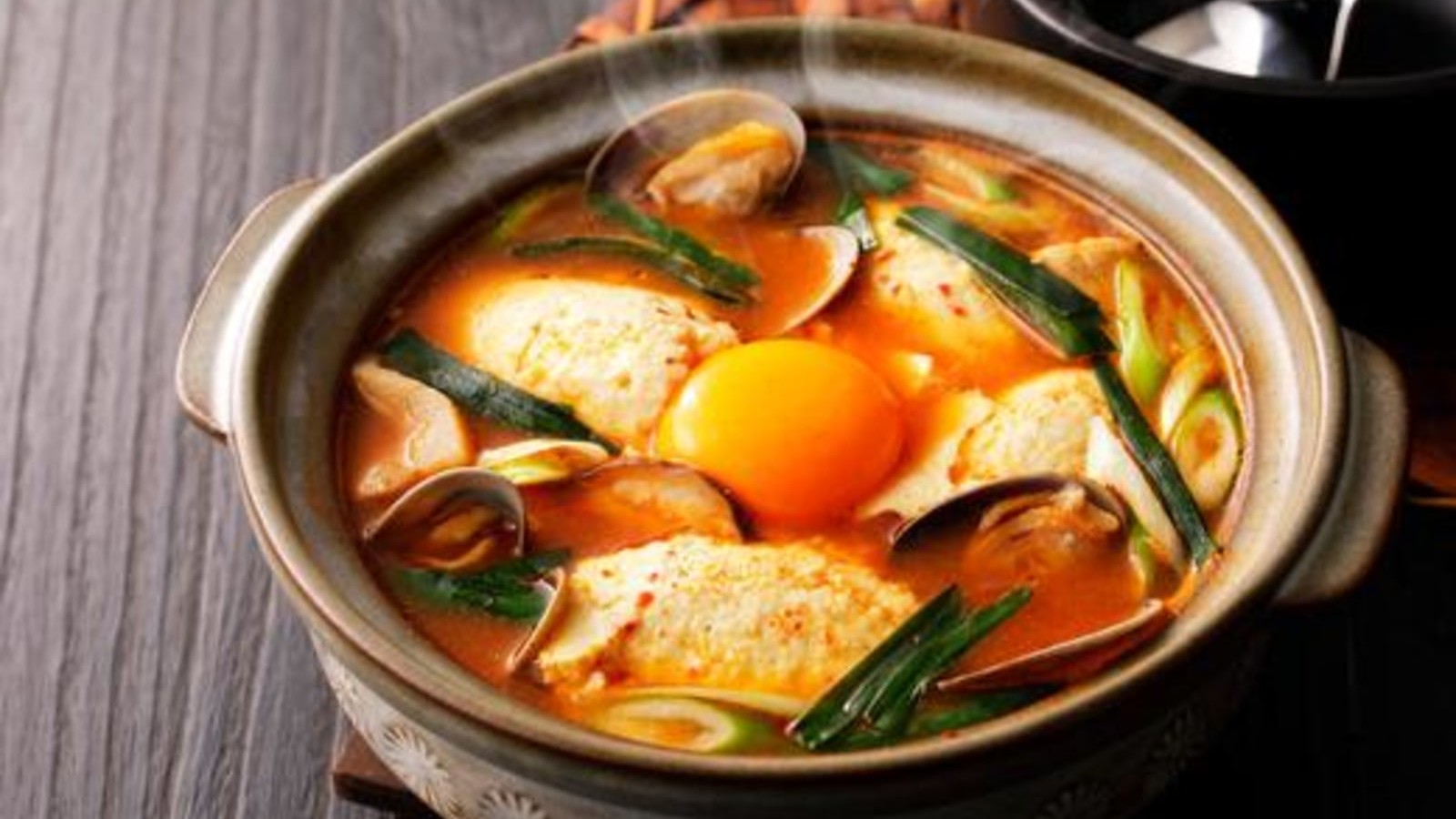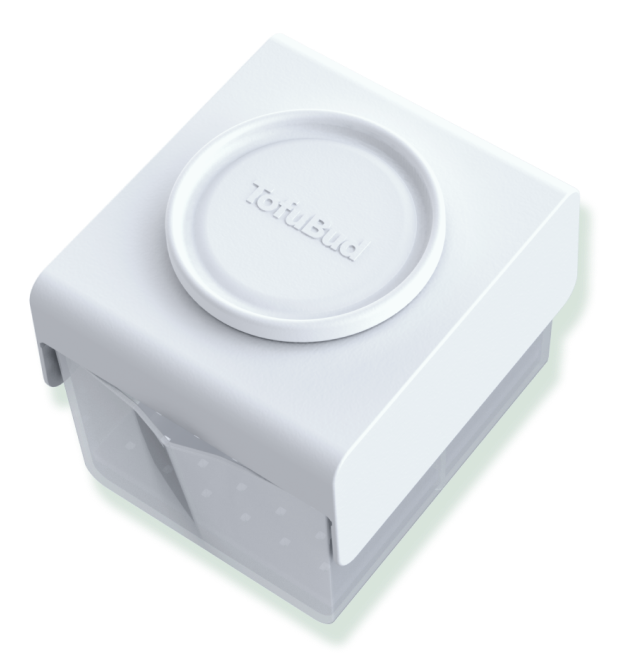Soondubu jjigae is a spicy Korean tofu stew that's as comforting as it is fiery. Brimming with chilli flakes and bursting with kimchi, this is a dish that will leave you craving more while your tongue continues to burn!
Soondubu jjigae is a delicious way to use extra soft tofu, and it can be tailored to suit any vegan or vegetarian lifestyle. Once you've gathered the ingredients from your local store, this classic Korean dish is surprisingly easy to prepare at home.
Prepare the tofu press, ready the kimchi, and fire up the stovetop; let's make soondubu jjigae. Here's our spicy Korean tofu stew recipe!
Soondubu recipe tips and FAQs
Before preparing your kimchi tofu soup recipe, check out our extra cooking tips and FAQs just in case you run into some questions mid preparation!
Here's how to perfect your soondubu jjigae.
What does soondubu jjigae mean?
Unless you've travelled to Korea or have a Korean restaurant nearby, you might not know what actually goes into this spicy tofu stew.
Soondubu is a type of tofu. Specifically, it's the Korean word for silken tofu. Silken tofu is the softest style of tofu you can find, and it forms the backbone of this Korean favourite. Directly translated, dubu is the Korean word for tofu, while soon is the prefix that lets us know we're talking about super-soft tofu.
Super soft tofu (soondubu) cooks into what Koreans call a jjigae, which simply means a stew or a soupy broth. Put it all together, and you have soondubu jjigae or soft tofu stew.
This particular Korean tofu soup makes use of many classic Korean ingredients, including kimchi, of course. It also includes gochugaru, which is better known as Korean chilli powder. The base is traditionally an anchovy broth; however, you can substitute this for a vegetable broth. On top of that, you can add mushrooms, scallions, and other vegetables too.
The result is hearty, spicy, yet comforting Korean tofu stew!
Which tofu is best for soondubu jjigae?
Soondubu jjigae is all about the tofu. Tofu is the centrepiece of this spicy Korean dish, so it's crucial to select the most appropriate style of tofu if you want to be authentic.
Specifically, this is a dish that requires the softest tofu you can find. Soondubu literally means soft tofu in Korean, after all. You will likely find tofu labelled as soondubu if you head to a Korean or Asian grocery store. This is often imported, so you'll win on the authenticity side.
You can also find silken tofu, or extra soft tofu, in most supermarkets these days. This does the same job as the imported tofu and could be a lot cheaper too.
Should I press my tofu?
One of the most vital steps when preparing any tofu is the pressing process. All tofu, whether it's super soft or extra firm, has surprisingly high water content. This liquid content stops the tofu from absorbing the flavours of the broth when you're cooking, leaving you with a somewhat watery and bland soup for dinner.
Before cutting your block of tofu into pieces, you first need to press the excess liquid out of the block. Do this simply by placing paper towels over the block and pressing down firmly with your hands or a chopping board. This method works, but it's not the most effective. You'll still be left with a bit of water.
An easier way to get rid of the excess liquid is to use a dedicated tofu press for the hard and messy work. Place your tofu inside and press out the extra water. When you're happy, remove the tofu, drain the liquid, and start preparing your soondubu jjigae.
How spicy is soondubu jjigae?
Traditionally, this is a very spicy dish, and it's not soondubu jjigae without a liberal helping of chilli flakes added to the broth. Of course, as you're preparing this at home, you can add as much or as little spice as you like.
We recommend two teaspoons of chilli powder flakes in the recipe, but this is just a baseline. If you're really not a fan of overpowering heat, then start with one teaspoon first. Let the soup simmer, then try a sip of the broth. If it's not spicy enough, add another.
If you love your spice, then add two, three, or even four teaspoons of chilli flakes to the broth!
Should I use gochujang for soondubu?
If you're going for the overly original recipe, then you should be using goachujang for this recipe. Goachujang is a very particular Korean spice more commonly referred to as Korean chilli powder.
It's prepared from sun-dried chillis, which have been ground up. It's not quite a powder, however, as the texture is still somewhat flakey. It's somewhere between chilli powder and chilli flakes.
You might find gochujang in speciality shops, but you might not. It's not always easy to come by. That's why in the recipe, we recommend using spicy chilli flakes (of any variety) for the sake of convenience. It's not quite as authentic, but it will still burn your taste buds!
Is Soondubu Jjigae healthy?
Soondubu jjigae is Korean comfort food. It's hearty, it's warming, and it's spicy. It's the sort of dish that's perfect for a cold winter day when you need a pick me up!
Soondubu jjigae has several health benefits. It's full of vegetables, offering a range of healthy nutrients, while tofu is packed full of protein. A bowl of tofu soup is surprisingly low calorie if it's vegetarian or vegan, although you should be mindful of the amount of oil you add to the broth.
Is soondubu jjigae vegan?
Traditionally, soondubu jjigae isn't a vegetarian or vegan dish, despite the fact it uses tofu as its base. You'll often find it served with pork or beef strips, which have been lightly boiled in the broth as it simmers. If you're not vegetarian or vegan, then feel free to add in a few strips of meat to accompany the rest of the ingredients.
Soondubu jjigae is also usually served with an egg. The dish is served boiling hot, and while still bubbling away, an egg is cracked straight into the broth. The egg adds an extra texture to the soup, but isn't suitable for vegans!
Vegans should also be careful of the kimchi they select. Kimchi is sometimes prepared with shrimp paste, so check if your kimchi is vegan friendly before purchasing.
Many recipes for Korean stew also call for an anchovy broth base, rather than a vegetable broth base. Again, if you're not vegan or veggie, then you can substitute the vegetable broth for anchovy broth. It gives the dish a much saltier and stronger tone, which isn't for everyone.
Can I reheat soondubu jjigae?
Soondubu jjigae isn't going to freeze well for the simple fact that tofu becomes mushy when thawed and reheated. However, this stew will easily stay fresh and tasty in the refrigerator for a few days if you have any leftovers at the end of the meal.
Reheat the stew by placing it back into a small pot and simmering on medium heat on the stovetop. Be sure that you reheat the stew all the way through before serving again. You can add a few extra vegetables or a cup of both to bulk out the leftovers if you need extra servings.
Will you be cooking soondubu jjigae at home?
Soondubu jjigae is a delicious, hearty, and spicy tofu soup. It's wonderfully adaptable too. Crack an egg or add meat if you're not veggie or vegan, or fill the broth with mushrooms, onions, and other vegetables and let the ingredients soak up the fiery broth!
It's a beautiful way to bring the tastes, smells, and flavours of Korea back home. With the right ingredients, it's surprisingly quick and easy to prepare too. Will you be cooking spicy soondubu jjigae at home this week? Grab a spoon and dig into this hearty Korean tofu stew.









Leave a comment (all fields required)